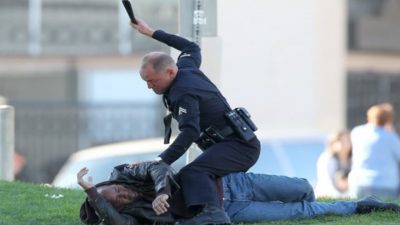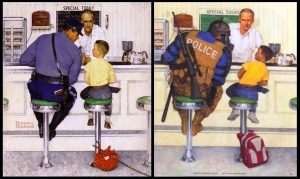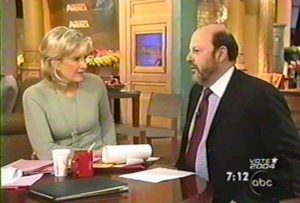A Practical Cure for the Curse of Qualified Immunity
The Doctrine of Qualified Immunity is Antithetical to Our System of Government, as it Deprives Americans of a Remedy for the Violation of their Constitutional Rights.
![Chief Justice John Marshall]() “It is a general and indisputable rule that where there is a legal right, there is also a legal remedy by suit or action at law whenever that right is invaded.” . . . The government of the United States has been emphatically termed a government of laws, and not of men. It will certainly cease to deserve this high appellation, if the laws furnish no remedy for the violation of a vested legal right.” Chief Justice John Marshall, Marbury v. Madison, 5 U.S. 137 (1803).
“It is a general and indisputable rule that where there is a legal right, there is also a legal remedy by suit or action at law whenever that right is invaded.” . . . The government of the United States has been emphatically termed a government of laws, and not of men. It will certainly cease to deserve this high appellation, if the laws furnish no remedy for the violation of a vested legal right.” Chief Justice John Marshall, Marbury v. Madison, 5 U.S. 137 (1803).
Almost All Constitutional Law is Made-Up by the U.S. Supreme Court.
In a very real sense, there is no United States Constitution. It is merely a document in the National Archives, and it never has been, nor will it ever be, anything other than what the Majority of Supreme Court Justices say it is.
Contrary to recent public statements by Supreme Court Justices that they don’t make policy decisions but simply interpret the law, 99% of what they do is to make policy decisions. United States Supreme Court Opinions on what the constitution states, on “what the law is“, are nothing more than what the Majority of the Justices want the Constitution to be.
Even the issue of whether the Supreme Court can overrule a co-equal branch of government (i.e. declare actions by the President or Congress unconstitutional) was made up by the Supreme Court in 1803 in Marbury v. Madison, 5 U.S. 137 (1803). It made-up the doctrine of Judicial Supremacy out of necessity. As Chief Justice Marshall stated, without Judicial Supremacy, the members of the other branches of government would be free to ignore the law and trample of the rights of the public.
Moreover, our precious Bill of Rights was never meant to be binding on the states and was only meant to be a restriction on the powers of the federal government. However, in Ohio ex re. Eaton v. Price, 364 U.S. 263 (1960) the Supreme Court changed all of that and held that the “Fourteenth Amendment’s due process clause (ratified by the states in 1868) incorporated all of those guarantees of the Bill of Rights that are “implicit in ‘the concept of ordered liberty”, and made those “fundamental rights” binding on the states.
Known as the “selective incorporation decisions” of the 20th and 21st Centuries; case by case, clause by clause, the Supreme Court chose and picked which provisions of the Bill of Rights they believed were “implicit in ‘the concept of ordered liberty”, and made those provisions binding on the states.
For example, the First Amendment’s protections were incorporated and made binding on the states between 1925 and 1984: Freedom of Speech (Gitlow v. New York, 268 U.S. 652 (1925)), freedom of the press (Near v. Minnesota 283 U.S. 697 (1931); Free Exercise of Religion (Hamilton v. Regents of the University of California, 293 U.S. 245 (1934)); Right of Assembly and Petition (DeJonge v. Oregon 299 U.S. 353 (1937)); guarantee against the Establishment of Religion (Everson v Board of Education, 330 U.S. 1 (1947)); Freedom of Expressive Association (even though not directly mentioned in the Amendment) (Roberts v. United States Jaycees 468 U.S. 609 (1984)).
The Second Amendment (right to bear arms) first became binding on the states in 2010 in McDonald v. Chicago, 561 U.S. 742 (2010).
The Fourth Amendment (search and seizures of persons, places and things) first became binding on he states in 1961 in Mapp v. Ohio, 367 U.S. 643 (1961).
The Fifth Amendment’s right against self-incrimination clause first became binding on the states in 1964 in Malloy v. Hogan, 378 US 1 (1964), and its “double jeopardy clause” was first made binding on the states is 1969 in Benton v. Maryland, 395 U.S. 784 (1969). However, the Fifth Amendment’s right to grand jury indictment has never been binding on the states, and was rejected as not being necessary for “ordered liberty” in 1884 in Hurtado v. California, 110 U.S. 516 (1884).
The Sixth Amendment’s right to counsel clause first became binding on the states in 1963 Gideon v. Wainwright, 372 U.S. 335 (1963), and the other provisions of the Sixth Amendment were incorporated between 1948 and 1967; Right to a Public Trial incorporated in In re Oliver, 333 U.S. 257 (1948); Right to notice of accusations incorporated in 1948 in In re Oliver 333, U.S. 257 (1948); Right to Confront Hostile Witnesses incorporated in 1965 in Pointer v. Texas, 380 U.S. 400 (1965); Right to an Impartial Jury incorporated in 1966 in Parker v. Gladden, 385 U.S. 363 (1966); Right to a Speedy Trial incorporated in 1967 in Klopfer v. North Carolina, 386 U.S. 213 (1967); Right to compulsory process to obtain witness testimony incorporated in 1967 in Washington v. Texas, 388 U.S. 14 (1967); and Right to Confront Favorable Witnesses incorporated in 1967 in Washington v. Texas, 388 U.S. 14 (1967).
The Seventh Amendment’s right to jury trial in a civil case was not deemed to be “implicit in ‘the concept of ordered liberty”, and has not been incorporated on the states.
Even those rights not mentioned in the Bill of Rights have become binding on the states via the Ninth Amendment, that provides: “The enumeration in the Constitution, of certain rights, shall not be construed to deny or disparage others retained by the people.”
The very purpose of the Ninth Amendment was a compromise during the Constitutional Convention of 1789 through 1791, between the Federalist Party, that wanted a strong federal government) and the Anti-Federalist Party, who were opposed to the Constitution, and wanted the power to remain in the states. The Anti-Federalists wanted at least minimum express guarantees of certain fundamental rights in the Constitution, and the Federalists feared that the enumeration of rights in the Constitution would be viewed as an exclusive list of rights; leaving the Courts powerless to find and create new and other rights.
The compromise reached was the Ninth Amendment, that expressly stated that those rights listed (“enumerated”) in the Bill of Rights were not the exclusive list of constitutional rights, and that the Supreme Court could and should find and create other rights not so enumerated in the text of the Constitution.
Lesson learned; almost all Constitutional Law is made-up by the Supreme Court. That is our system. The problem isn’t the system. The problem is who is making those decisions on what the Constitution is. Elections have consequences, and one of those consequences is the draconian doctrine of qualified immunity.
All Immunities from Criminal Prosecution and from Civil Lawsuits Are Made-Up by the U.S. Supreme Court.
One area of often criticized policy decisions by the Supreme Court is in the area of immunities of government officials from criminal prosecution and from lawsuits. There are no immunities mentioned in the Constitution. However, the Supreme Court has for many years made decisions regarding who can sue and be sued, based purely on policy considerations; on whether they believe that certain government officials should or should not be subject to being sued, and, if so, when.
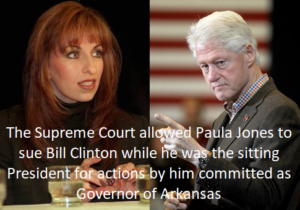 For example, in Clinton v. Jones, 520 U.S. 681 (1997), the Supreme Court held that a civil lawsuit against a current President may proceed if it is unrelated to behavior that occurred during that President’s time in office. However, the Supreme Court also has held that the President cannot be sued at all, ever, for any official actions committed by the President. See, Nixon v. Fitzgerald, 457 U.S. 731 (1982).
For example, in Clinton v. Jones, 520 U.S. 681 (1997), the Supreme Court held that a civil lawsuit against a current President may proceed if it is unrelated to behavior that occurred during that President’s time in office. However, the Supreme Court also has held that the President cannot be sued at all, ever, for any official actions committed by the President. See, Nixon v. Fitzgerald, 457 U.S. 731 (1982).
With regard to certain other government officials, such as prosecutors, judges and similar officials, the Supreme Court has created doctrines of absolute immunity from criminal prosecution and from lawsuits (i.e. Eastland v. United States Servicemen’s Fund, 421 U. S. 491 (1975); absolute immunity of legislators for any legislative actions); Imbler v. Pachtman, 424 U.S. 409 (1976)(absolute immunity of prosecutors for filing or prosecuting any criminal action, no matter how frivolous, malicious and done in bad-faith); Stump v. Sparkman, 435 U. S. 349 (1978) (absolute immunity of judges for any actions done by them in their judicial capacity; also, no matter how unlawful or malicious]).
Other federal officials who are trying to qualify for absolute immunity have the burden to prove “that public policy requires an exemption of that scope.” If they do not have absolute immunity, they have qualified immunity. Police officers only have qualified immunity.
Our modern-day doctrine of qualified immunity, is not just another cruel and misguided policy decision; it’s one that may, in the words of Chief Justice John Marshall, turn the United States into “a government of men, and not a government of laws“, thwarting the American ideal that no one is above the law.
As Chief Justice Marshall stated in Marbury v. Madison, “It is a general and indisputable rule that where there is a legal right, there is also a legal remedy by suit or action at law whenever that right is invaded.” Accordingly, when there is no remedy, there is no right. With the modern-day application of qualified immunity, our precious United States Constitution is often now nothing more than a “parchment barrier“.
The Draconian Doctrine of Qualified Immunity is Similarly Made Up by The U.S. Supreme Court.
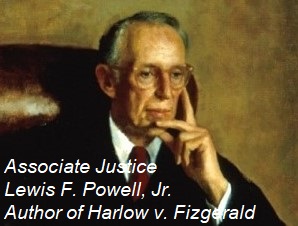 Qualified immunity is one of the most obviously unjustified legal doctrines in our nation’s history. It is a judicial doctrine created by the Supreme Court that shields government officials, such as police officers, from liability for their misconduct, even when they break the law.
Qualified immunity is one of the most obviously unjustified legal doctrines in our nation’s history. It is a judicial doctrine created by the Supreme Court that shields government officials, such as police officers, from liability for their misconduct, even when they break the law.
Qualified immunity was first created by the U.S. Supreme Court in Harlow v. Fitzgerald, 457 U.S. 800 (1982). In that case the Supreme Court held that federal government officials are entitled to qualified immunity, because “the need to protect officials who are required to exercise discretion and the related public interest in encouraging the vigorous exercise of official authority”, requires that they carry out their duties, free from concern that they might be sued for doing so. This was a pure policy decision; nothing more.
In its modern-day form, qualified immunity prevents government agents from being held personally liable for constitutional violations unless the violation was of “clearly established law“, which usually requires specific precedent on point with the case before the court; both factually and legally.
Qualified Immunity is simply another doctrine made-up by the Supreme Court for policy reasons; to protect the police from liability for their outrages. It has drastically hampered the ability of victims of constitutional violations by public officials from obtaining redress in the courts. It allows the federal courts to contemporaneously declare that a civil rights plaintiff’s constitutional rights were violated, but he/she is nonetheless not entitled to be compensated for the violations of those rights, making a mockery of the Bill of Rights.
The application of qualified immunity to real cases of even the most egregious constitutional violations is day by day, case by case, turning the United States into a police state. Unless you can show the court binding precedent that is so factually and legally similar to your case that no judge could possibly argue with a straight face that the police were not reasonably put on notice that such actions constituted constitutional violations, you lose; even when that same judge in that same case also declares that your constitutional rights were violated.
The issue of whether there was a constitutional violation must also be “beyond debate” See, Stanton v. Sims, 571 U.S. 3 (2013). In the legal world almost nothing is “beyond debate“. Accordingly, in the real world with real judges, if any reasonable judge might have deemed the action permissible, the law is not “clearly established”; at least not for you. Moreover, the Supreme Court has now changed the qualified immunity analysis to essentially prevent any future cases of similar police outrages from being shown as constitutional violations; thus continuing to allow the police to continue to commit those same constitutional violations in perpetuity.
In Saucier v. Katz, 533 U.S. 194 (2001), an excessive force case, the Supreme Court held that the police could “reasonably act unreasonably“; no joke. The Ninth Circuit Court of Appeals had held that since under Graham v. Connor, 490 U.S. 386 (1989), the inquiry in excessive force cases was “whether a reasonably well-trained police officer would have believed that the force used was reasonable“, and as the qualified immunity inquiry was exactly that same standard, that qualified immunity was not a viable defense in excessive force cases. This is logical.
 However, turning logic on its head (expressly to protect the police), the Supreme Court held that a police officer could “reasonably act unreasonably“, and established the order in which the qualified immunity defense must be analyzed. Under Saucier v. Katz, the Supreme Court held:
However, turning logic on its head (expressly to protect the police), the Supreme Court held that a police officer could “reasonably act unreasonably“, and established the order in which the qualified immunity defense must be analyzed. Under Saucier v. Katz, the Supreme Court held:
- First, a court must look at whether the facts indicate that a constitutional right has been violated,
- If so, a court must then look at whether that right was clearly established at the time of the conduct complained of.
Under the Saucier v. Katz two-step approach, even if the police were awarded qualified immunity, at least the issue of whether that particular police conduct constituted a constitutional violation would be settled for future cases.
This is important for three reasons:
1) it puts the police on notice for future cases that a repeat of such conduct would be a constitutional violation, and, therefore, would no longer be immunized by qualified immunity.
2) as qualified immunity is not a defense that is available to the employing public entity (i.e. City Police Department or County Sheriff’s Department), if a policy or longstanding custom or practice of the employing public entity was a proximate cause of that police conduct, the plaintiff would still be entitled to obtain redress (i.e. a money judgment) for that conduct under Monell v. Dept. of Social Services, 436 U.S. 658 (1978; and
3) at least the issue of whether the police conduct at issue would be decided in the context of a civil case, and not in the context of a suppression motion in a criminal case, where the courts typically bend over backwards to find that there was no constitutional violation by the police as so to not have to let the guilty criminal defendant go free.
However, eight years later the Saucier v. Katz two-step approach was abandoned in Pearson v. Callahan, 555 U.S. 223 (2009). In Pearson, the Supreme Court further gutted American’s constitutional rights by holding that a court may now decide whether the police are entitled to qualified immunity from suit, without first deciding whether the police conduct at issue constituted a constitutional violation at all.
This leaves the only forum for deciding whether certain police conduct is a constitutional violation to be decided in suppression motions in criminal cases; something that usually results in the courts chopping away at constitutional rights so as to not allow the guilty party go free, because “the constable has blundered“.
In suppression motions in criminal cases, the criminal defendant moves the trial court to exclude (“suppress”) incriminating from evidence at trial, on the ground that such evidence was the “the fruit of the poisonous tree“; evidence obtained by the police in violation of the criminal defendant’s constitutional rights. So for example, if the police searched the defendant’s house without a warrant, or without an exception to the warrant requirement, the incriminating evidence must be suppressed from the evidence at trial, and the guilty party usually goes free. Judges do not like to let the guilty go free; especially in cases with real victims.
Accordingly, appellate courts often find that police conduct that was heretofore considered a constitutional violation, no longer is; chopping-down our precious constitutional rights until one day, there are no rights left. The innocent no longer have those constitutional protections against police actions because the guilty used those rights to escape criminal liability.
The Supreme Court has left the door open for plaintiffs to prevail against the police when no prior case has declared such conduct unconstitutional when such police actions are so outrageous that any reasonably well-trained officer would have known that such actions were constitutional violations. Those case, however, are far and few between.
Accordingly, in the real world, due to the doctrine of qualified immunity, our constitutional rights are shrinking on a daily basis, because rights do not exist without a remedy to enforce them, and because those rights that are recognized, are being shriveled away via rulings on whether police conduct constitutes constitutional violations in the context of suppression motions in criminal cases.
Unless we change course and resume holding police officers responsible for their constitutional violations, someday, we will look back and realize that those rights no longer exist, and that we are now living in a police state. This doesn’t happen starkly and overnight. It is a long and slow process to go from our free society to a police state; so gradually, that no one notices.
Qualified Immunity is Antithetical to the Remedy that Congress Created for Violation of Federal Constitutional Rights.
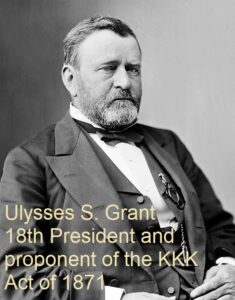 The Ku Klux Klan in the Post-Civil War Southern states was the local Sheriff and his posse, who often terrorized the local Southern population because black persons now had the right to vote with the ratification of the 15th Amendment to the U.S. Constitution. The local Sheriff and his posse (persons acting “under the color of state law“), often murdered black persons of African descent, or otherwise violated their federal constitutional rights.
The Ku Klux Klan in the Post-Civil War Southern states was the local Sheriff and his posse, who often terrorized the local Southern population because black persons now had the right to vote with the ratification of the 15th Amendment to the U.S. Constitution. The local Sheriff and his posse (persons acting “under the color of state law“), often murdered black persons of African descent, or otherwise violated their federal constitutional rights.
Because there are no rights without a remedy, in order to enforce the Fourteenth Amendment’s guarantee of liberty and equal protection of the laws, Congress enacted, 42 U.S.C. § 1983; the Ku Klux Klan Act of 1871, also known as the Third Enforcement Act to enforce the Fourteenth Amendment.
Now commonly known as “Section 1983”, 42 U.S.C. § 1983 provides:
“Every person who, under color of any statute, ordinance, regulation, custom, or usage, of any State or Territory or the District of Columbia, subjects, or causes to be subjected, any citizen of the United States or other person within the jurisdiction thereof to the deprivation of any rights, privileges, or immunities secured by the Constitution and laws, shall be liable to the party injured in an action at law, suit in equity, or other proper proceeding for redress . . .”
42 U.S.C. § 1983 gives persons who are subjected to the violation of their federal constitutional rights by those acting “under the color of state law” (i.e. the police) a remedy for the violation of those constitutional rights; a right to sue the offending government officials. However, as shown below, our constitutional rights are shrinking by the day, due to the federal courts awarding the police “qualified immunity” from lawsuits under Section 1983.
Fourth Amendment Jurisprudence on Qualified Immunity in Excessive Force Cases.
The Fourth Amendment to the United States Constitution provides:
Amendment IV
“The right of the people to be secure in their persons, houses, papers, and effects, against unreasonable searches and seizures, shall not be violated, and no warrants shall issue, but upon probable cause, supported by oath or affirmation, and particularly describing the place to be searched, and the persons or things to be seized.”
Since 1989, the Supreme Court has held that police excessive force cases are proscribed as unreasonable seizures of persons under the Fourth Amendment. See, Graham v. Connor, 490 U.S. 386 (1989). However, a civilian (or their survivors when the force causes death) who is subjected to such an “unreasonable seizure” of their person, as a practical matter in the real world, often has a slim or no chance of obtaining the redress provided for under Section 1983.
To show that the police are not entitled to qualified immunity from suit in Fourth Amendment cases, in the real world of Fourth Amendment jurisprudence, if there is no prior binding appellate opinion (legal precedent) that is just like your case, unless the police have handcuffed you, hung you upside down and are using you as a piñata, you will have great difficulty convincing a court that such conduct was so obviously outrageous that you win. Of course, real world considerations really have more to do with the judge on your case than the legal analysis, as excessive force is often more of a political concept than a factual one; especially with juries.
This makes excessive force cases a steep uphill battle. Such cases turn on the Fourth Amendment — a constitutional right that is “notorious for its murky and context-specific contours”. Proving a Fourth Amendment violation is hard enough on its own. When you have to prove a “clearly established” violation, the task becomes all but impossible because the Supreme Court keeps raising the bar. This further disempowers those injured or killed by police, and their surviving families.
As Justice Sotomayor stated in a 2018 Dissenting Opinion in a police shooting case of a mentally ill lady who posed no threat to either the officers or any bystanders:
“Officer Andrew Kisela shot Amy Hughes while she was speaking with her roommate, Sharon Chadwick, outside of their home. The record, properly construed at this stage, shows that at the time of the shooting: Hughes stood stationary about six feet away from Chadwick, appeared “composed and content,” and held a kitchen knife down at her side with the blade facing away from Chadwick. Hughes was nowhere near the officers, had committed no illegal act, was suspected of no crime, and did not raise the knife in the direction of Chadwick or anyone else. Faced with these facts, the two other responding officers held their fire, and one testified that he “wanted to continue trying verbal command[s] and see if that would work.”But not Kisela. He thought it necessary to use deadly force, and so, without giving a warning that he would open fire, he shot Hughes four times, leaving her seriously injured. If this account of Kisela’s conduct sounds unreasonable, that is because it was. And yet, the Court today insulates that conduct from liability under the doctrine of qualified immunity, holding that Kisela violated no “clearly established” law. I disagree.Viewing the facts in the light most favorable to Hughes, as the Court must at summary judgment, a jury could find that Kisela violated Hughes’ clearly established Fourth Amendment rights by needlessly resorting to lethal force. In holding otherwise, the Court misapprehends the facts and misapplies the law, effectively treating qualified immunity as an absolute shield. I therefore respectfully dissent.”Andrew Kisela v. Amy Hughes, 584 US. ____ (2018); Sotomayor, J., dissenting.
Fourth Amendment Jurisprudence in Illegal Seizure of Property Cases.
As mentioned above, the actual text of the Fourth Amendment protects Americans from unreasonable searches and seizures of persons, places and things. It would seem more than obvious and logically “beyond debate“, the police actually stealing one’s property would fall into the unreasonable seizure of property case category. After all, what could be more of an unreasonable seizure of one’s property than the police actually stealing the same. Nonetheless, even the “liberal” Ninth Circuit Court of Appeals has protected the police for doing just that.
For example, in Jessop v. City of Fresno, No. 17-16756 (9th Cir. 2019), Fresno Police Officers stole Jessop’s property during the execution of warrant. They found and seized $276,000.00 in cash and coins during the search of Jessop’s home, but only turned-in $50,000.00; keeping $226,000.00 for themselves.
In awarding the stealing police officers qualified immunity from Jessop’s lawsuit, the Ninth Circuit held that there was no clearly established law holding that officers violate the Fourth or Fourteenth Amendments when they steal property seized pursuant to a warrant. For that reason, the City Offices were entitled to qualified immunity from Jessop’s lawsuit.
Moreover, this is one of those cases where under Pearson v. Callahan, 555 U.S. 223 (2009), mentioned above, the Ninth Circuit never decided if police officers stealing money during search warrant executions constituted an unreasonable seizure of property under the Fourth Amendment, the police will not be held accountable for stealing money from search warrant targets in the future.
This Author’s Own Clients Being Deprived of Their Constitutional Rights Via Absurd Qualified Immunity Decisions.
One does not have to look far to find absurd Qualified Immunity decisions. Even in the Nineth Circuit Court of Appeals, a Circuit traditional viewed as a fairly liberal one, ridiculous Qualified Immunity decisions rule the day. This author has had many obvious righteous claims dismissed by the District Courts and the Ninth Circuit Court of Appeals based on ridiculous qualified immunity decisions.
For example, in Merritt Sharp v. County of Orange, ___F.3d____ (9th Cir. 2017), a 73-year-old man whose son was on probation heard the police outside of his home. The Orange County Sheriff’s Department deputies were looking for Mr. Sharp’s son for parole and probation violations, and had warrants for his son’s arrest. However, Mr. Sharp’s son did not live at his home.
When the deputies arrived, they placed a band-aid over the peep-hole on Mr. Sharp’s front door, that blocked him from looking outside with his door closed. When Mr. Sharp heard the police radios outside, he exited his home and approached the Sheriff’s Department deputy sheriffs to find out why they were there. He admittedly violated no law and posed no threat whatsoever to the deputies.
One of the deputy sheriffs grabbed Mr. Sharp, pushed his arm behind his back up toward his neck (“chicken-winged” him), slammed him to the ground and brutally handcuffed him; causing his wrists to bleed. They placed him in the back seat of their patrol car, with Mr. Sharp handcuffed and having suffered a torn rotator cuff injury and cut wrists. The deputies had neither had a right to have even touched Mr. Sharp at all, nor did they suspect that he was his son; the person they were looking for.
Notwithstanding the obviousness of Mr. Sharp suffering an “unreasonable seizure” of his person, the Ninth Circuit Court of Appeals awarded the deputies qualified immunity from Mr. Sharp’s false arrest and excessive force claims, holding:
“a. The Initial Arrest Was Unconstitutional
In a case of mistaken identity, “the question is whether the arresting officers had a good faith, reasonable belief that the arrestee was the subject of the warrant.” Defendants counter that it was nighttime, and the situation was dynamic and evolving, but that does not give officers the license to arrest anyone near the scene of a fleeing suspect. It was thus unreasonable for Deputies Anderson and Flores to conclude that Sharp III was the subject of the arrest warrant. The initial arrest of Sharp III therefore violated the Fourth Amendment.b. The Violation Was Not Clearly EstablishedAlthough unconstitutional, the arrest was not clearly proscribed by established federal law. The Supreme Court has repeatedly instructed that we examine “whether the violative nature of particular conduct is clearly established” by controlling precedent, not whether the conduct violates a general principle of law.. . . . we require a specific precedent or principle that would have alerted Deputies Anderson and Flores that their specific conduct, or at least conduct more closely analogous to their own, was unlawful. Finding none, we conclude they were entitled to qualified immunity as to the initial arrest based on mistaken identity.B. Use of Excessive Force Against Sharp IIISharp III claims that Deputy Anderson violated the Fourth Amendment by using excessive force when Sharp III was arrested. Taking the facts as offered by Plaintiffs, Deputy Anderson yanked Sharp III’s left arm behind his back—thereby causing a rotator-cuff tear which required surgery—and then applied handcuffs that were tight enough to break Sharp III’s skin. While the degree of force here was significant, Deputy Anderson was entitled to qualified immunity because Plaintiffs have not offered anything other than general legal propositions which cannot clearly establish that Deputy Anderson’s particular conduct was unlawful.” Merritt Sharp v. County of Orange, ___F.3d____ (9th Cir. 2017),
This author also represented Mr. Sharp in another case involving his being subjected to a 45-minute detention by Garden Grove, California, police, who were looking to arrest his son, and was awarded a $1,010,000.00 verdict in 2000 against the City of Garden Grove for detaining him at his auto body shop. However, that incident took place in 1997; before the courts went completely “off the rails” with the qualified immunity defense.
In another one of this author’s federal civil rights case, the Ninth Circuit Court of Appeals again went off the rails, and awarded Newport Beach Police Department police officers qualified immunity for slamming a totally innocent young lady against the walls of her apartment and slamming her face first down on her apartment floor, when she simply told the officers that she did not invite them into her home.
In Ashley Watts v. City of Newport Beach, Newport Beach Police Department police officers were summoned to Ashley Watts’ apartment complex, in response to a call for service for a taxi driver complaining that Ms. Watts didn’t pay for her $16.00 cab ride.
When the NBPD officers arrived at the scene, they taxi driver complained that Ashley Watts’ credit card had been declined, due to fraudulent activity on the credit card. The credit card company had issued Ashley Watts a new credit card to replace the one deactivated, but when she left her home that night, she accidentally grabbed the old credit card.

The officers told Ms. Watts that they would not permit her to go to her apartment to get the cash to pay for the cab ride, and that if she didn’t pay the cabbie now that she was going to jail.
When the officers finally allowed her to go to her apartment to get the cash to pay the cabbie, the officers then walked inside behind her. When Ms. Watts told them that she didn’t invite them the officers closed the door behind them and told Ms. Watts “Then you’re going to jail”. The officers then slammed Ms. Watts against the wall of her apartment, slammed her on the floor and took her to jail. See, Newport Beach Pays $360,000 to Woman Falsely Arrested over $16 Cab Ride.
Although the Ninth Circuit Court of Appeals allowed Ashley Watts to recover damages for her false arrest, the Circuit Court also held that the officers were entitled to qualified immunity from her claims of excessive force:
“As to Watts’s excessive force claim, the district court erred in determining that it could not conclude that the use of force was reasonable because the officers lacked probable cause. Use of force may be reasonable even in the absence of probable cause. See, Arpin v. Santa Clara Valley Transp. Agency, 261 F.3d 912, 921–22 (9th Cir. 2001). Notwithstanding the lack of probable cause, the court erred by not addressing whether the force used was “objectively reasonable in light of the facts and circumstances” confronting the officers. Bryan v. MacPherson, 630 F.3d 805, 823 (9th Cir. 2010) (quoting Graham v. Connor, 490 U.S. 386, 397 (1989)). And our precedent does not clearly establish that the officers used unreasonable force in this circumstance. See Arpin, 61 F.3d at 921-22.
The district court’s denial of qualified immunity as to Watts’s claims for unlawful arrest and unlawful entry are AFFIRMED. However, we REVERSE the denial of qualified immunity on Watts’s excessive force claim.” Ashley Lauren Watts v. City of Newport Beach, 18-55833 (9th Cir. 2019).
The Remedy for the Curse of Qualified Immunity; Respondeat Superior Liability for Municipal Employers.
Respondeat Superior Liability in Anglo-American Jurisprudence.
Under the common-law doctrine of respondeat superior, employers are generally responsible for the torts committed by their employees in the course and scope of their employment. The justification for imposing this vicarious liability on employers for the acts of employees is well-known. It creates an incentive for the employer to exercise special care in the selection, instruction and supervision of its employees, thereby reducing the risks of accidents or other tortious actions by them.
Employers have a degree of control over their employees through hiring, firing, discipline, and setting employment policies. Moreover, employees will not have the financial resources to pay a judgment for the damage caused by their tortious conduct, but the employer usually will. The employee also acts in a manner to financially benefit the employer, so society places the burden to compensate those persons injured by the employer’s enterprise on the employer. This has been a staple of English common-law since the 17th Century, and in the United States since the creation of the Republic.
Simply put, if an employee of Coca Cola is driving a Coca Cola truck, delivering Coca Cola to your local grocery store, and the driver accidentally drives through a red light and injures a motorist, the injured motorist can sue Coca Cola for his/her damages. We are all familiar with this principle.
Because There Presently is No Respondeat Superior Liability Under 42 U.S.C. § 1983, Many Section 1983 Plaintiffs Have No Remedy At All.
Although government employers have the same degree of control over their employees, they are generally immune from liability when their employees hurt people by violating the Constitution.
In addition to “sovereign immunity“, the un-American concept of “the King can do no wrong” that prevents Americans from suing the federal or state government directly unless the government consents to be sued, the Supreme Court has created another doctrine to protect cities, counties, and other lower-level government employers from being sued for constitutional rights violations by its officials and officers.
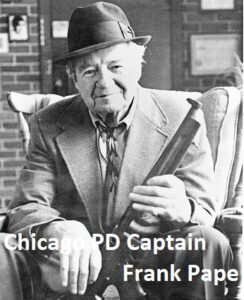 In, Monroe v. Pape, 365 U.S. 167 (1961), the Supreme Court revived the Ku Klux Klan Act of 1871, 42 U.S.C. § 1983 , and allowed persons who federal constitutional were violated by person acting under the color of state law, to sue those government agents; in that case and in the usual case, the police. However, Monroe v. Pape also held that the victims of constitutional violations could only sue the government agents, and not their Municipal employers, such as cities and counties.
In, Monroe v. Pape, 365 U.S. 167 (1961), the Supreme Court revived the Ku Klux Klan Act of 1871, 42 U.S.C. § 1983 , and allowed persons who federal constitutional were violated by person acting under the color of state law, to sue those government agents; in that case and in the usual case, the police. However, Monroe v. Pape also held that the victims of constitutional violations could only sue the government agents, and not their Municipal employers, such as cities and counties.
Seventeen years later, in Monell v. Department of Soc. Svcs., 436 U.S. 658 (1978), the Supreme Court reversed Monroe v. Pape’s prohibition on suing municipal employers (i.e. cities and counties). However, Monell v. Department of Soc. Svcs. also held that such municipal entities can only be sued for the violation of one’s constitutional rights unless the victim of those constitutional violations can show that those violations flow directly from an official policy or custom of the municipal entity employer. Making that showing, that a policy or longstanding custom of the employing police agency is often a Herculean task, for two reasons.
First, most police agencies don’t have written policies telling their officers to violate constitutional standards. Although many, if not most police departments have a substantial percentage of officers who routinely unjustifiably beat-up, tase, pepper-spray or shoot innocents and others, usually for “contempt of cop” (failing the attitude test), the department’s policy manual expressly forbids such conduct.
Accordingly, in order to prove that a police agency’s officers routinely engage in such constitutional violations and/or that the agency routinely fails to discipline its officers for engaging is such conduct, a Section 1983 plaintiff needs to obtain personnel / Internal Affairs records from other cases; lots of other cases.
Police agencies generally fight any efforts of Section 1983 plaintiffs from obtaining personnel / Internal Affairs records from even the case that they are litigating. They will make the plaintiff move the District Court to compel discovery of such documents, and the United States Magistrate Judges who handle those discovery issues usually only will order such documents to be turned over to the plaintiff pursuant to a protective order; preventing the dissemination of the information to anyone not involved in that case. In Section 1983 cases in states courts, like those in California, as a practical matter, you just don’t get those records.
Moreover, police agencies generally will fight to the death any efforts of Section 1983 plaintiffs from obtaining personnel / Internal Affairs records from other cases. The United States Magistrate Judges will often not allow a Section 1983 plaintiff from obtaining personnel / Internal Affairs records from other cases, often calling such discovery efforts “fishing expeditions”.
Also, from a practical standpoint, in order to obtain that discovery of personnel / Internal Affairs records from other cases, the plaintiff’s lawyer needs to expend hundreds of hours of work on discovery efforts and motions, and most lawyers have neither the time, nor the money, nor the desire to do so.
Second, Federal Rule of Civil Procedure 8 that establishes pleading standards for Complaints in federal court. Rule 8 mandates that Complaints in federal court lawsuits need not contain any more specific facts than to place the defendant on notice as to what the plaintiff is basically alleging in the case (“Notice Pleading“).
In recent years, when a Section 1983 plaintiff files a lawsuit (Complaint) in federal court, United States District Judges, and even some United States Court of Appeals judges, make the plaintiff prove their allegations that a City of County had a particular policy or custom, such as using excessive force on the public, in their Complaint, by alleging many other prior incidents of similar misconduct by that police agency’s office. This is basically impossible.
Accordingly, at an early stage in the case, the allegations of municipal liability are dismissed, and the Section 1983 plaintiff is now disabled from being able to prove, or to even conduct discovery on the policies, customs and practices of the municipal police employer.
Therefore, it is a rare occasion that a Section 1983 plaintiff is able to actually obtain a direct judgment against the employer of the violating police officers. Qualified Immunity leaves the Section 1983 plaintiff with no remedy against the violation officer, and the perversion of Rule 8 federal pleading standards to allege liability against the officer’s municipal entity employer results in disabling Section 1983 plaintiffs from obtaining a judgment against the municipal entity. This results in the Section 1983 plaintiff having no remedy at all when his/her constitutional rights are violated.
Thanks to Monell, short of a municipal employer formally instructing its employees to violate the Constitution, it is very difficult to hold a government employer accountable. And to make things worse, courts have recently begun using qualified immunity to further erode what little constitutional accountability exists for government employers.
The Cure for the Curse of the Judicially Created Doctrine of Qualified Immunity; Respondeat Superior Liability Under 42 U.S.C. § 1983.
Because qualified immunity is immunity from suit for personal liability against police officers, and as qualified immunity is a defense available to the municipal employers of police officers, all that Congress needs to do is to pass a statute stating that 42 U.S.C. § 1983 is a respondeat superior statute. Such a statute will cure the curse of qualified immunity. Persons who constitutional rights are violated will finally be compensated for those violations. Constitutional rights will once again be enforceable, and, therefore, exist.
Transition from a free society to a police state doesn’t happen overnight. It takes place slowly, case by case, so no one notices that our rights are basically gone. It’s like parents seeing their children grow-up day by day and year by year. They don’t notice the changes in their children’s growth as great changes in them. However, if you see your niece of nephew when they are five years old, and then don’t see them until you are at their wedding, they do not look like the same person. So goes the transformation from the free society to the police state. It happens gradually and unnoticeably.
This current curse of the qualified immunity doctrine is something that hastens our decline from a free society to a police state. It flies in the face of that great statute enacted by Congress following the American Civil War, to provide all American’s a right to obtain redress for the violation of their precious constitutional rights; the Ku Klux Klan Act of 1871. In the real world, in most states, the public entity that employs police officers and deputy sheriff’s are already liable for any judgment / award against such officers anyway. See for example, Cal. Gov’t Code § 825. However, under our present system (qualified immunity) the City, County or the State itself is never called upon to pay the public for constitutional violations by its deputy sheriffs and police officers.
As a public entity is never entitled to qualified immunity from suit, making 42 U.S.C. § 1983 is a respondeat superior statute will restore the Constitutional rights of Americans. The officers will still be entitled to qualified immunity for personal liability for damages, but those whose constitutional rights were violated will finally be able to obtain redress for those violations from the officer’s employing state, City or County.
Congress needs to act now and make this so.
Jerry L. Steering, Esq.

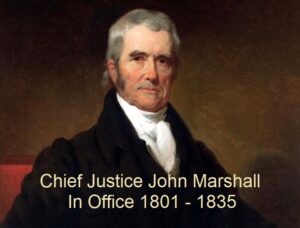 “It is a general and indisputable rule that where there is a legal right, there is also a legal remedy by suit or action at law whenever that right is invaded.” . . . The government of the United States has been emphatically termed a government of laws, and not of men. It will certainly cease to deserve this high appellation, if the laws furnish no remedy for the violation of a vested legal right.”
“It is a general and indisputable rule that where there is a legal right, there is also a legal remedy by suit or action at law whenever that right is invaded.” . . . The government of the United States has been emphatically termed a government of laws, and not of men. It will certainly cease to deserve this high appellation, if the laws furnish no remedy for the violation of a vested legal right.” 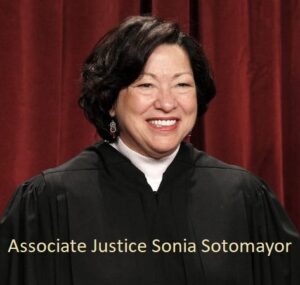
 “a. The Initial Arrest Was Unconstitutional
“a. The Initial Arrest Was Unconstitutional

